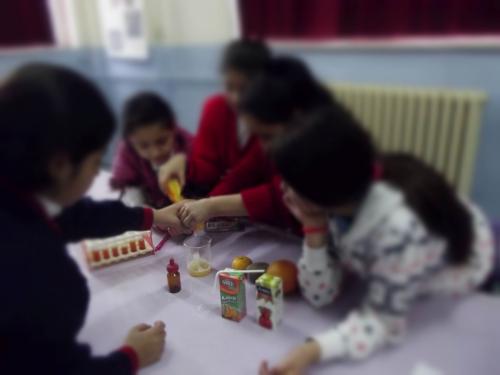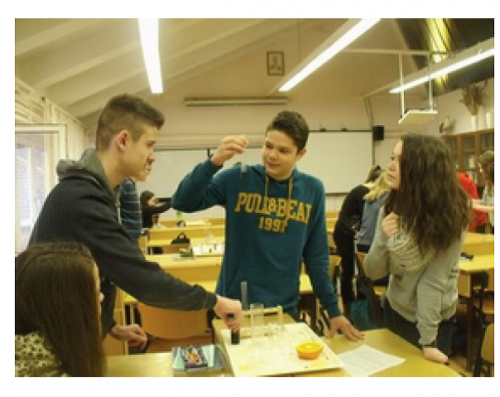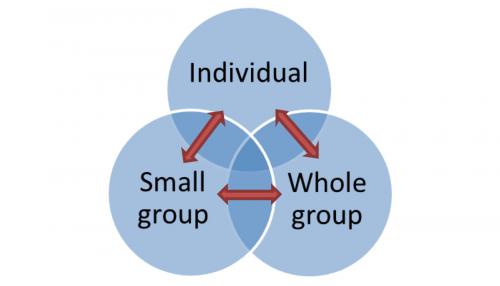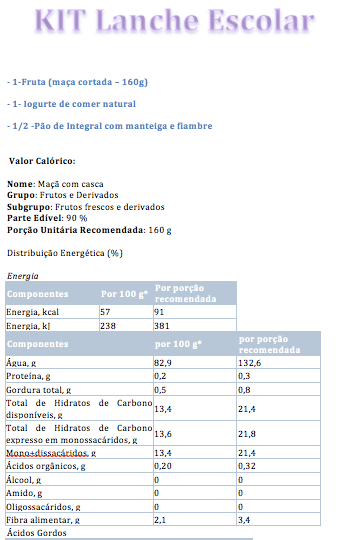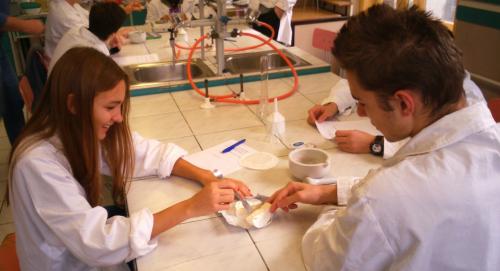The Food and food labels SAILS inquiry and assessment unit was designed to aid students to understand food labels and the composition of foods. Through the four outlined inquiry activities, students learn to look at the composition of foods and the amounts needed to keep someone healthy. In this way, students become equipped with sufficient knowledge and skills to make the choices that they need to when it comes to their own diet. The unit is recommended for implementation as a guided inquiry at lower second level.
Two key skills are identified for development in this unit. Scientific reasoning, in particular proportional reasoning, is developed as students compare different amounts and types of food in their diet. Students’ skills in working collaboratively are also developed, through discussion and teamwork. The assessment methods described include classroom dialogue, teacher observation and evaluation of student artefacts.
The unit was trialled by teachers in Turkey, Hungary, Ireland and Portugal – producing five case studies of implementation. Four examples at lower second level are presented (aged 11-15 years), while one Hungarian class and the Portuguese study detail adaptation for upper second level (up to 19 years). In all cases the unit was implemented as a guided inquiry, with some open opportunities. In addition to the assessment of scientific reasoning and working collaboratively, opportunities for the assessment of skills in developing hypotheses, planning investigations and forming coherent arguments were identified.
- Balanced diet
- Food groups
- Understand food label information
- Lower
- Upper
- Planning investigations
- Developing hypotheses
- Forming coherent arguments
- Working collaboratively
- Scientific reasoning
- Scientific literacy
- Classroom dialogue
- Teacher observation
- Self-assessment
- Worksheets
- Student devised materials
- Presentations
The teaching and learning activities described in the Food and food labels SAILS inquiry and assessment unit were developed by the team at Kings College London for use in the SAILS project. The unit is developed in four parts (activities A-D), in which students are introduced to food groups and nutritional composition of foods. This is included in the school curriculum in the hope that students will begin to understand what makes a healthy balanced diet. They can then look at their own diet and that of others and make recommendations about how to improve the diet. The problem however is that too often the ideas behind obtaining a balanced diet are not considered in sufficient detail to allow youngsters to understand what a balanced diet means in reality with foods simply categorised as healthy or unhealthy or as fat or protein and the true composition of foods and the amounts needed to keep someone healthy are not looked at. So youngsters are not equipped with sufficient knowledge and skills to make the choices that they need to when it comes to their own diet. This set of materials attempts to help with developing better ideas about food and incorporates an inquiry-based approach to aid the skills development required and also to motivate students to want to understand these ideas better.
In this unit, the key skills developed are scientific reasoning and working collaboratively, and several opportunities for assessment of these skills have been highlighted. For example, in Activity A: Packed lunches, assessment can be achieved by listening to groups talk as they work out the answers and also when groups report back on their answers to the whole class. The teacher should encourage the students to explain how they reach their answers and get them to compare their methods with those of other students. For assessment, students’ ability to articulate how they solved the problems is more important than obtaining the correct answer. A four-level rubric for assessment of working collaboratively is proposed, which allows for assessment of students’ skill in collaboration and debating with peers. In Activity D: Testing for vitamin C, students’ skills in developing hypotheses and other investigative skills such as planning investigations and collection of data can be assessed. A sample rubric for assessment of developing hypotheses is provided.
Below you can find the full inquiry and assessment unit for download, as well as an archive with classroom materials, including student worksheets and assessment tools for teachers to be used during the activities if available.
Unit booklet Classroom materials| Concept focus |
Comparing the nutritional content of different food items
Calculations using ratios
|
| Inquiry skills focus |
Working collaboratively
|
| Scientific reasoning |
Proportional reasoning
|
| Scientific literacy |
Evaluating the nutritional content of food
|
| Assessment methods |
Classroom dialogue
Teacher observation
Worksheets
|
| Concept focus |
Comparing the nutritional content of different food items
Introducing food groups – carbohydrates, fats and protein
|
| Inquiry skills focus |
Working collaboratively
|
| Scientific reasoning |
Proportional reasoning
|
| Scientific literacy |
Evaluating the nutritional content of food
|
| Assessment methods |
Classroom dialogue
Teacher observation
Worksheets
|
| Concept focus |
Carbohydrate, fats and proteins in the diet
Comparing the nutritional content of different food items
|
| Inquiry skills focus |
Working collaboratively
|
| Scientific reasoning |
Proportional reasoning
|
| Scientific literacy |
Evaluating the nutritional content of food
|
| Assessment methods |
Classroom dialogue
Teacher observation
Worksheets
|
| Concept focus |
Comparing the vitamin C content of different food items
|
| Inquiry skills focus |
Planning investigations
Developing hypotheses
Working collaboratively
|
| Scientific reasoning |
Recording data and observations
|
| Assessment methods |
Classroom dialogue
Teacher observation
Worksheets
|
This unit was trialled in four countries, producing five case studies of its implementation – CS1 Turkey, CS2 Hungary, CS3 Ireland, CS4 Portugal and CS5 Hungary. The case studies detail implementation at lower second level, as recommended in the unit, except in CS4 Portugal and one class in CS5 Hungary, which features a 9th grade class (upper second level). The ages of the students involved in the case studies were aged 11-19 years, thus teachers varied the implementation to suit the requirements of their respective class groups. The students in each class were mixed ability and mixed gender, except in CS3 Ireland where the students were all female. The case studies were implemented by teachers who had some experience of teaching through inquiry, but the students involved had generally not been taught through inquiry previously.
For CS3 Ireland and CS5 Hungary the selected inquiry activities were carried out in one lesson of 45-60 minutes. CS1 Turkey and CS2 Hungary implemented most elements of the unit over two 45-minute lessons. Finally, CS4 Portugal implemented one unit activity (food cards) over five lessons (60 minutes each).
The case studies detail a range of implementations and adaptations, and the skills assessed vary from focusing entirely on working collaboratively in CS5 Portugal, to assessment of each of the SAILS inquiry skills and competencies in CS2 Hungary. The assessment methods described include on-the-fly interactions and structured dialogue, teacher observation, evaluation of worksheets and student devised materials and self-assessment (in CS4 Portugal).
The inquiry approach used across the case studies was guided inquiry, as the teachers felt that they needed to introduce some ideas about nutrition and diet before the students commenced the activities. The teachers then set the inquiry question and the students worked collaboratively on the various activities.
In all case studies, the students worked in groups. All schools, except that of CS3 Ireland, were mixed gender, while the Irish school was a girls’ school. No specific choices were made by the teacher as to how to group the students for the activities beyond whom the teacher felt would work well together.
In each of the case studies, the students explicitly or implicitly dealt with the concept of healthy diets and food choice. CS2 and CS5 (both Hungary) carried out most of the activities in the unit, with CS5 Hungary dividing some of the activities to be done by younger groups and others for older groups. In CS5 Hungary, students produced their own food labels by looking up food composition, when no food labels were available for the activity. In the other case studies, the teachers chose particular aspects and activities for implementation.
While for several of the classes an inquiry learning approach was a relatively new approach, it was clear that teachers had begun to look at opportunities for formative assessment as well as documenting summative achievements. Perhaps one of the most relevant findings was that students enjoyed and were motivated by the inquiry activities and the teachers seemed relatively confident in both facilitating the inquiry and assessing it.
In the various implementations, several different approaches to assessment were taken and different skills were identified for assessment. All case studies used the context of nutrition and making healthy food choices to introduce the topic, but did not necessarily assess students on this, instead focusing on development of inquiry skills. Most commonly used assessment methods were on-the-fly interactions, structured dialogue and evaluation of students’ worksheets or other artefacts.
Below you can find the full inquiry and assessment unit for download (excluding the case studies), as well as an archive containing all the case studies.
Unit booklet Case studies| Concept focus |
Proportional reasoning
Vitamin C content in everyday foods
|
| Activities implemented |
Packed lunches
Testing for vitamin C
|
| Inquiry skills assessed |
Developing hypotheses
Working collaboratively
|
| Scientific reasoning |
Proportional reasoning
Drawing conclusions
|
| Assessment methods |
Classroom dialogue
Teacher observation
Worksheets
|
| Level |
Lower
|
| Age |
11-12
|
| Prior experience with inquiry |
Some experience
|
| Concept focus |
Composition and nutritional values of foods
Designing a healthy meal
|
| Activities implemented |
Packed lunches
Food cards
The washing line
Testing for vitamin C
|
| Inquiry skills assessed |
Planning investigations
Developing hypotheses
Forming coherent arguments
Working collaboratively
|
| Scientific reasoning |
Proportional reasoning
Collecting data
|
| Scientific literacy |
Analysis and interpretation of data
|
| Assessment methods |
Classroom dialogue
Worksheets
|
| Level |
Lower
|
| Age |
14
|
| Prior experience with inquiry |
No experience
|
| Concept focus |
Making informed food choices
Developing inquiry skills
|
| Activities implemented |
Food cards
|
| Inquiry skills assessed |
Forming coherent arguments
Working collaboratively
|
| Assessment methods |
Classroom dialogue
Student devised materials
|
| Level |
Lower
|
| Age |
12-14
|
| Prior experience with inquiry |
No experience
|
| Concept focus |
Nutritional composition of food
Making healthy food choices
|
| Activities implemented |
Food cards
|
| Inquiry skills assessed |
Working collaboratively
|
| Scientific reasoning |
Problem-solving
|
| Assessment methods |
Classroom dialogue
Teacher observation
Self-assessment
Student devised materials
Presentations
|
| Level |
Upper
|
| Age |
14-19
|
| Prior experience with inquiry |
No experience
|
| Concept focus |
Nutritional composition of food
Making healthy food choices
|
| Activities implemented |
Food cards
The washing line
Testing for vitamin C
|
| Inquiry skills assessed |
Planning investigations
Working collaboratively
|
| Scientific reasoning |
Making reasoned decisions
|
| Scientific literacy |
Critical thinking
Collection and analysis of scientific data
|
| Assessment methods |
Classroom dialogue
Teacher observation
Worksheets
Student devised materials
|
| Level |
Lower
Upper
|
| Age |
14-16
|
| Prior experience with inquiry |
Some experience
|

